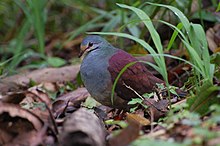Costa Rican quail pigeon
| Costa Rican quail pigeon | ||||||||||
|---|---|---|---|---|---|---|---|---|---|---|

Costa Rican quail pigeon |
||||||||||
| Systematics | ||||||||||
|
||||||||||
| Scientific name | ||||||||||
| Zentrygon costaricensis | ||||||||||
| ( Lawrence , 1868) |
The Costa Rican quail pigeon ( Zentrygon costaricensis , syn .: Geotrygon costaricensis ) is a ground-dwelling species of pigeon birds that is one of the quail pigeons . It is a compact and short-tailed species with a predominantly reddish-brown plumage that occurs in Central America.
The population of the Costa Rican quail pigeon is given as least concern . No subspecies are distinguished.
Appearance
The Costa Rican quail pigeon reaches a body length of 24 to 28.5 centimeters. The wing length is 13.6 to 14.2 centimeters. The weight is between 225 and 283 grams. There is only a slight sexual dimorphism , the females are only slightly more dull in color.
Adult Costa Rican quail pigeons
The forehead is white-brown and merges into a blue-gray on the crown. The nape, the back of the neck and the upper coat are pale pastel green, the rest of the defect is shiny purple. The rest of the top of the body is reddish brown. The back, rump and upper tail-coverts shine purple-red. The wings are dark olive brown, the three innermost wings have isabel-colored feather hems on the outer flags.
The chin and throat are white. The face is whitish, the sides of the head are light gray. A striking black streak of beard delimits the face. The front neck and chest are pale blue-gray, the sides of the chest have a slightly greenish tone. The belly and the underside of the tail are whitish with a slight shade of brown. The flanks are cinnamon colored. The tail plumage is blackish on the underside with gray feather tips. The iris is dark brown, the orbital ring is coral red. The beak is black, the legs and feet are red-purple.
Fledglings
Young birds are generally duller and mostly reddish brown in color. The forehead is matt cinnamon brown and the parting is matt gray. The upper plumage has mostly brownish feather edges, so that the young birds appear diffusely transversely banded.
Possible confusion
In the distribution area of the Costa Rican quail pigeon, the white -forehead pigeon and the gray-headed pigeon also occur, both of which belong to the sounding pigeons . Both species have a significantly slimmer build and a proportion of white in the tail plumage. The red earth dove , like the Costa Rican quail dove, occurs at high altitudes. The males have a much more reddish brown plumage than the Costa Rican quail pigeon, the females are predominantly dull olive. Both sexes lack the black stripe of beard and the white face, and their upper body plumage also has a more intense metallic sheen.
Distribution area
The Costa Rican quail pigeon is an infrequent species of pigeon in the humid subtropics of Costa Rica and Panama. It occurs predominantly in the highlands and populates, for example, in the west of the Chiriquí province , Panama, altitudes between 1200 and 3000 meters above sea level.
The habitat are moist subtropical mountain forests. It is dependent on largely intact undergrowth and, in forests with selective logging, is limited to areas where a dense secondary forest is developing.
Habits
The Costa Rican quail pigeon is a distinct resident bird that only lives in a limited area. It does not go on seasonal hikes and does not go far from its food and water sources during the day. She is extremely shy and hardly noticeable. It occurs exclusively solitary or in pairs, however, groups of this species with a greater number of individuals have never been observed. It lives exclusively on the ground, rarely flies up and, when in danger, takes cover on foot in the undergrowth.
It finds its food in the leafy layer on the forest floor and in the dense undergrowth, and it avoids clearings. It eats seeds, small fruits, insects, larvae and caterpillars.
The reproductive biology of this species has not yet been conclusively investigated.
literature
- David Gibbs, Eustace Barnes and John Cox: Pigeons and Doves - A Guide to the Pigeons and Doves of the World . Pica Press, Sussex 2001, ISBN 90-74345-26-3 .
- Gerhard Rösler: The wild pigeons of the earth - free living, keeping and breeding . M. & H. Schaper Verlag, Alfeld-Hannover 1996, ISBN 3-7944-0184-0 .
